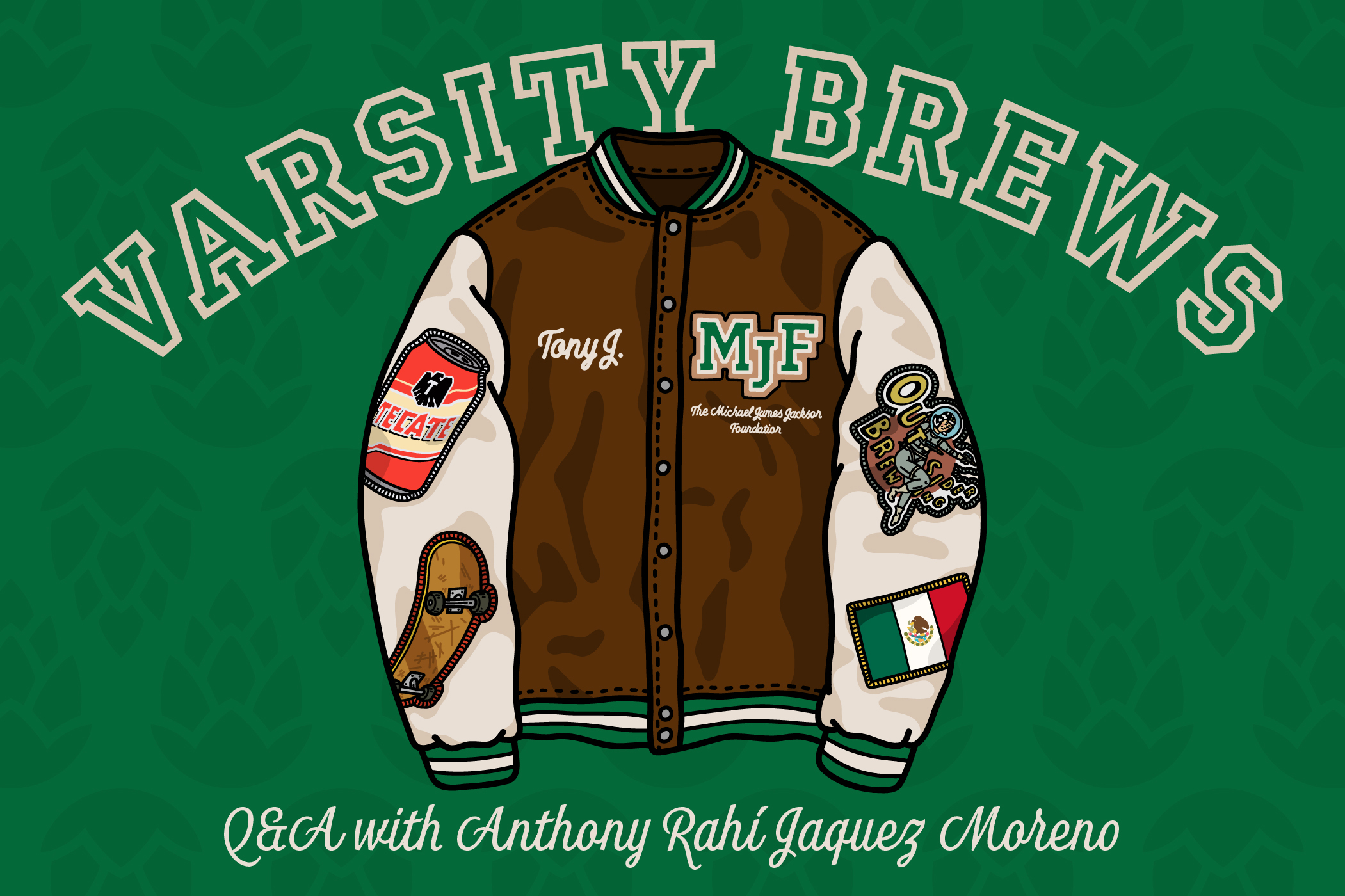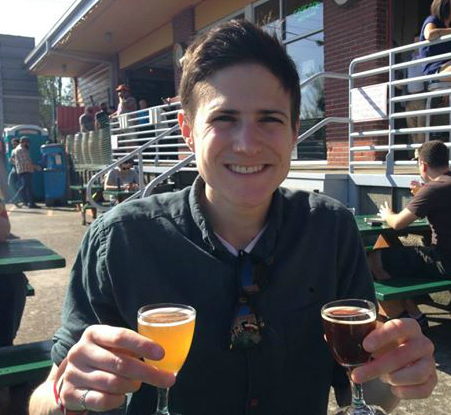Shop
Varsity Brews: 12 Questions With Anthony Rahí Jaquez Moreno aka Tony J
A new Hop Culture Q&A series.
Like This, Read This:
Last month, we introduced an entirely new series called Varsity Brews. With each bi-monthly piece, we’ll profile a different scholarship awardee from the Michael James Jackson Foundation for Brewing & Distilling (MJF).
Remind Me, What Is the MJF?
Named after Michael James Jackson, one of the world’s most incredible beer and whiskey writers, the foundation strives to make the craft beer industry more diverse, just, and equitable by providing scholarship opportunities to underrepresented communities.
Recently, the MJF released its first Impact Report, tracking the foundation’s contributions to lowering financial barriers for people of color interested in technical brewing and distilling education.
According to the report, since starting the foundation in 2020, Oliver and the MJF have provided funding for scholarships for fifty-eight different People of Color in the industry, distributing $507,214 in funding directly to tuition and learning materials at accredited institutions.
“While there are many paths to great careers in brewing and distilling, formal education can be critical. We are proud of the work we have done to bring this level of expertise to a broader community. If this industry is to grow, we need everybody on board, both as producers and as customers”, said Garrett Oliver, founder and president of The MJF, which also recently received “Cause of the Year Award” from Brewbound and “Nonprofit of the Year Award” from VinePair. “This Impact Report is a testament to the hard work of our awardees, the generosity of our supporters, and the collective effort to create a more diverse industry. We gain momentum every year, and I can’t wait to see what The MJF and its awardees will accomplish in 2025 and beyond.”
The MJF aims to rewrite that narrative, equipping People of Color in the industry with the tools and education to advance in this industry despite its systemic barriers.
These are educational opportunities that often come with a tremendous cost.
“What does a certificate cost? Four thousand dollars? Twelve thousand dollars? Twenty-three thousand dollars? Thirty-three thousand dollars?” remakred Oliver, admitting that even when he sat in the brewmaster chair, he required any new applicant to either have two to three years of experience or a certificate. “I thought I was doing the right thing, but it turned out that no Brown people ever showed up.”
A scholarship from the MJF covers those expenses and helps ensure that Black and Brown people can attend those interviews or even further their established businesses.
“If you don’t know how meaningful that is, ask them; ask me,” said Oliver. “I wished to god there was someone there for us. We have their back. And that’s important. You have their back. This is a beautiful thing.”
So, we took Oliver’s advice.
Introducing Anthony Rahí Jaquez Moreno aka Tony J
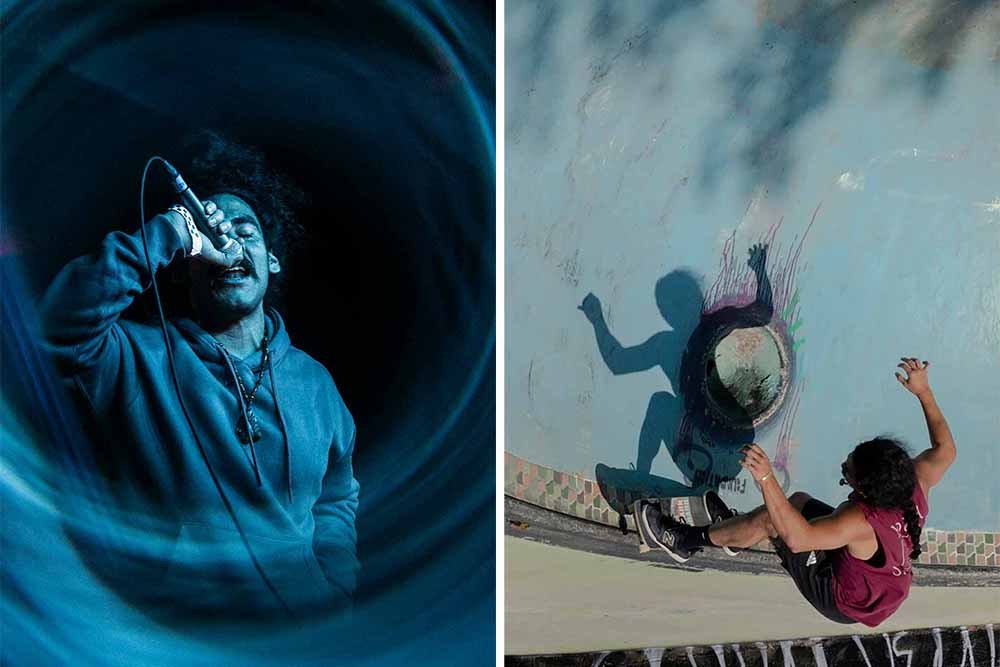
Photography courtesy of Anthony Rahí Jaquez Moreno
Originally from Tijuana, Mexico, Anthony Rahí Jaquez Moreno, fondly known as Tony J, left home at twenty years old to study at the University of Nevada in Reno.
Actually, the Tijuana native didn’t want to leave his hometown, but his parents insisted he go study in the States for the “quote, unquote American dream,” he tells me from his studio in Asheville, NC. “But I just wanted to make music and be in Tijuana, my home.”
The international business major eventually realized he had the brain of an engineer, just like his parents, and switched to mechanical engineering his second year in college.
After graduation, Tony stayed on for his master’s, working as a TA (another similarity to his parents, who both ended up going into higher education teaching at Tecnologico de Tijuana.
When his wife secured a job on the East Coast, the pair moved to Maryland. Because he was still an international student, Tony only had limited time to find a job. “My clock was ticking,” he shares. “If I didn’t get a job, I’d have to kick rocks, essentially.”
With only ninety days to get hired, Tony found a job on day seventy-six as a mechanical engineer in the patent world. He drew mechanical drawings and worked part-time as an adjunct faculty at Howard Community College.
Tony thought he’d done it. He’d achieved “this so-called immigrant dream,” he says.
But instead of feeling fulfilled, the mechanical engineer, who also skateboarded on the side, made music, and loved being active outdoors, felt trapped.
“I very quickly felt myself just shrinking and shrinking more into this tiny little desk,” he recalls, “until one day I was like, ‘Why am I so unhappy with my life?”
Then, Tony, the Tijuana native who had no homebrewing experience and had never worked in the beer industry (but who had drunk plenty of beer), decided to get out from behind the desk and into the brewhouse.
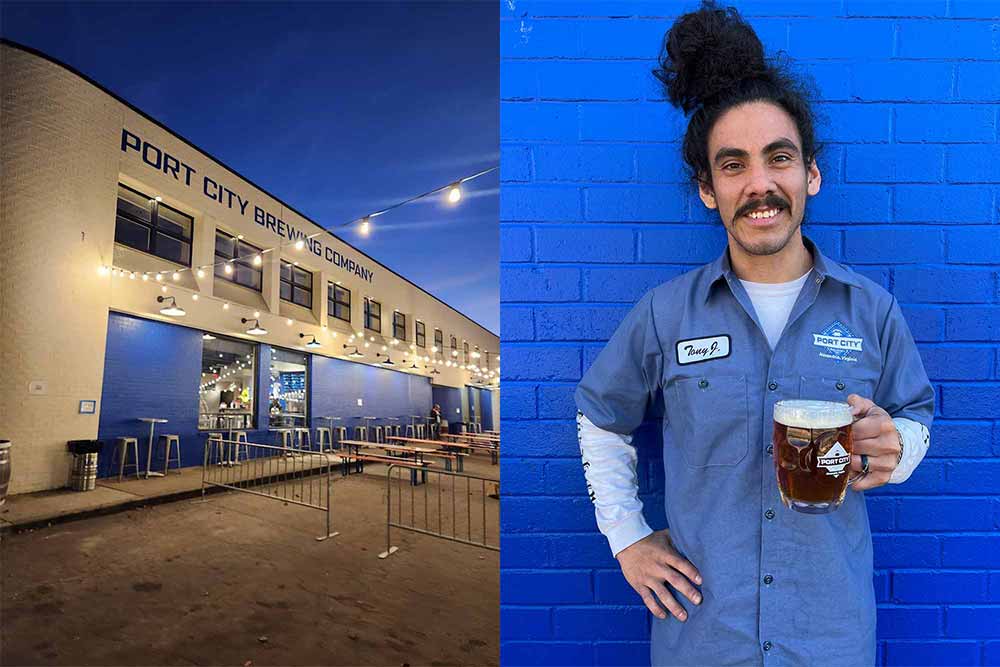
Photography courtesy of Port City Brewing
After sliding into breweries’ DMs to land his first gig, Tony worked his way from behind the bar at House Six to packaging at Port City Brewing to what he now calls a “sweat equity partner” at Outsider Brewing in Asheville, NC. In the last two and a half years, Tony says they’ve brewed over 105 beers. His favorites include a wild persimmon ale, a dark lager using Epiphany and Riverbend Malt, a beer-cider hybrid fermented with a wild culture Solera and local apple juice, and a collaboration rice kölsch with Louisiana chef Jay Ducote featuring Louisiana rice.
But perhaps the beer he’s most proud of is a beer he designed for the brewery’s wild program based on an ancestral drink called Tepache, a fermented beverage made from the peel and rind of pineapple.
“However, since our Brett house culture provides us with pineapple and vanilla notes, I decided to use this strain and skip the pineapple skins,” explains Tony, noting they used all local Riverbend Malt House grains for the base. “For fermentables, I utilized malted corn and barley (the original Tepache was an all-corn fermented beverage) and piloncillo.”
During his time in Asheville, Tony also earned the MJF’s Sir Geoff Palmer Scholarship for Brewing. This scholarship has helped pay for his two-year associate degree in brewing, distillation, and fermentation at A-B Tech, from which he will graduate in May.
Often going to class from 9 a.m. to 3 p.m. three or four days a week before going to the brewery to work, Tony says he’s learned to be extremely patient and kind with himself, reminding himself that it’s just beer. “We try our hardest, but we’re also human beings,” he says. I want to promote a culture of sustainability not just from an ingredient standpoint but from the standpoint of human beings.”
Along the way, he says the people he met who believed in him helped him grow, and the educational opportunities he earned in the industry have “been like a second lifeline to me.”
The antithesis of the typical American craft beer story, Tony hopes to share his passion and pass on his skills and knowledge to others in the community.
He hopes to one day open breweries in border towns like Tijuana and San Diego. He believes this dual project can showcase what each city can culturally bring to beer under one brand and give folks like him an opportunity to do something they never thought possible.
“I want to grab people,” he shares enthusiastically, “and be like, ‘Hey, did you know this could also be you?’”
We sat down with Tony to chat about the mirage of the “American dream,” how beer became a second lifeline, and how he plans to use a beer and a border, not to separate the U.S. and Mexico, but to bring them together.
12 Questions with Tony J, 2023 Recipient of the Sir Geoff Palmer Scholarship for Brewing at the MJF
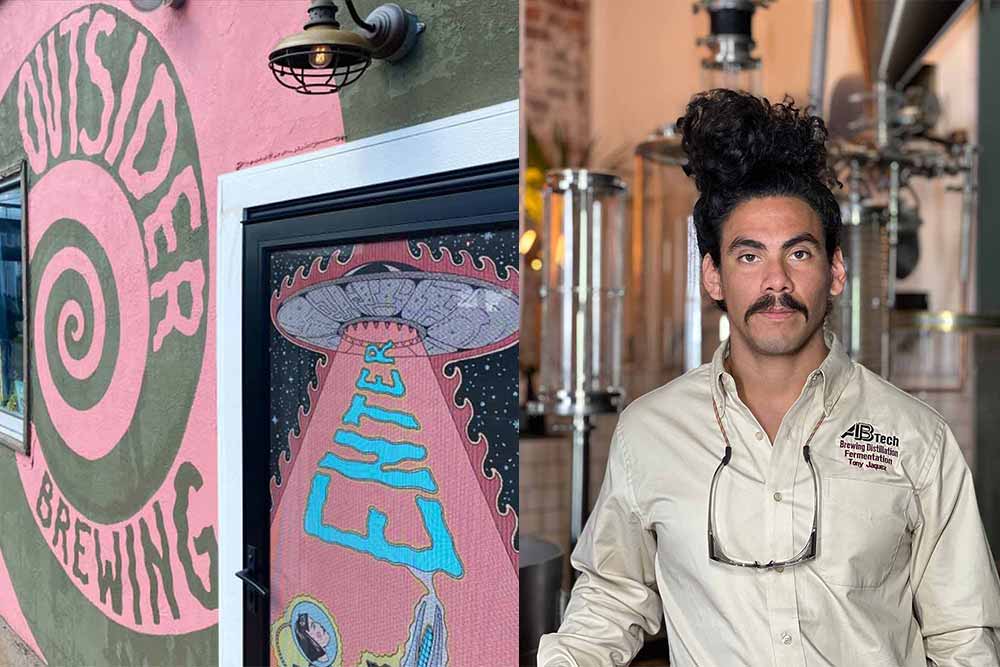
Photography courtesy of Outsider Brewing and Anthony Rahí Jaquez Moreno
Editor’s Note: Portions of this interview have been shortened for brevity.
Grace Lee-Weitz: How did you first discover beer?
Anthony Rahí Jaquez Moreno aka Tony J: I grew up in Tijuana. The brewery Tecate is from a town called Tecate, an hour and a half away. In the fourth grade, I think we went to see the giant factory, so I knew of it, but it wasn’t anything that interested me. But I’m from Mexico, so I was drinking beer when I was eighteen and, wink wink, even before that!
GLW: So what was the first craft beer you tried?
TJ: My first experience of what people call IPAs I asked, what is this EEE-PA! They’re like, it’s an I-P-A. Well, what is it? It just happened to be from Sierra Nevada because we were in Reno, which is not far from Chico. My knowledge of beer was small [at that point].
There was this cool spot by the river where people like to party, hang out, and kick it in Reno called the [Sierra Tap House]. It’s an amazing bar with a pool table, shuffleboard, and all Sierra Nevada beer—a giant board with all these different beers written on it, everything and anything you could think of. I didn’t know what was up at the time, but the first beer I tried off the top was a Sierra Nevada Pale Ale.
The first time I tried hoppy beers, I became obsessed with them because they were completely different for me. I will never forget that experience.
GLW: We all have one of those stories, right!? For me, I was drinking with some friends in a little dingy bar in Wrigleyville by the Cubs stadium when I randomly decided to order something other than a Busch Light. This was before Goose Island sold to AB-Inbev, so I went for one of three taps the bar had on draft—a Goose Island 312, which, by the way, I also mispronounced. At the time, I had no idea the 312 stood for the Chicago area code. That hazy American wheat beer was unlike anything I’d ever tasted.
TJ: We became friends with the bartender, and he told us he had this new beer that wasn’t quite out yet. They were calling it a hazy IPA! He only had like two kegs of it. Oh my god, to this day, I haven’t tried a hazy IPA like that one. It was an amazing and crazy experience. Reno was not a place for craft beer; it was a place for alcohol and partying, but everyone had a bunch of craft beer in the fridge because we were so close to California. If you asked any of us to describe it, we couldn’t; it just tasted really good. So I look back on those experiences, and I’m like, damn, I was really just from the get-go in the right place drinking really good stuff without even knowing it!
GLW: That’s too funny. Obviously, when you were in Reno, you didn’t have any dream of going into the beer industry. You studied mechanical engineering and eventually found a job working as one in the patent world. At that point, you thought you were living the so-called “American dream,” but you felt trapped more than anything. How did you make that leap that changed your life and decide to pursue working in beer?
TJ: I felt so unfulfilled [working as a mechanical engineer]. What was I going to do? Live thirty more years like that and then just be a curmudgeon? Someone told me, dude, you could work behind the bar anywhere. Okay, let’s see how that goes.
I kid you not; I applied to probably fifteen places but didn’t hear back from anyone. Maybe they thought it was a mistake because I didn’t have any industry experience and it just looked like all this engineering stuff. Or maybe they thought I was square and couldn’t survive behind the bar.
You know what? I’m going to slide into some of these breweries’ DMs.
House 6 Brewing responded immediately. They were all from Puerto Rico, so they spoke Spanish. It was perfect. That was my first gig behind the bar.
GLW: Nice! Did you feel at home right away? When did it start to click?
TJ: At that point, I didn’t know anything about brewing or how beer was made. I was just clueless. Then I looked back into the brewery and saw all these things that were very familiar to me, like piping, tanks, pumps, temperature controls, and buttons. I’m like, dude, what’s going on over here! The head brewer at the time said I could shadow a brew or clean some kegs. My eyes just lit up. Yes, please!
GLW: You also worked at Port City Brewing in Alexandria, VA, during that time, too, right?
TJ: While I was at House 6, another brewery I had applied to hit me back up, which was Port City. Between both breweries, I just started acquiring knowledge. Eventually, I got a packaging position at Port City. I started working doubles and triples, going from packaging and switching from my boots to my comfy shoes to work the bar.
GLW: Busy! So how did you end up in Asheville?
TJ: We moved to North Carolina because we couldn’t afford being in that DMV area anymore. Even though Asheville is very expensive right now, it wasn’t as expensive when we moved. At the time, I wasn’t hip to the brewing industry here. Again, I’m a total outsider from a different country, and I came into this industry with a whole other degree where I’d never even homebrewed. I was hired by a brewery called Outsider Brewing. They were looking for someone with both front-of-house and back-of-house experience. Dude, that was me. I was like, I got you one hundred percent! I’m also the one who will be there as early as you need with my boots on and ready to do grunt work. I’m here for it!
GLW: While you were at Outsider, you received a scholarship from MJF that allowed you to get a two-year associate degree in brewing, distillation, and fermentation at A-B Tech. You’re graduating this May. What does that feel like?
TJ: The opportunity that MJF gave me to get this associate’s degree, in those two years, I’ve done so much and learned so much that makes me feel very skill-ready. I’ve also been able to use the tools they gave me at school in my job.
GLW: Can you share an example?
TJ: I have here one of our rare bottle-conditioned beers—TYT Wild Ale. It’s called TYT because the team was like, Thank you, Tony, for doing this. I took our wild solera to school … and isolated a specific Brett strain that just gives you pineapple and vanilla notes. I brought it back to work, and now we have a pure culture of just this pineapple-vanilla Brett. At Outsider, a lot of the cool things that happen, the magic, is not even the place itself; it’s just the people who are so passionate.
GLW: You’ve spoken a lot about how many people influenced and helped you along the way. With your graduation coming up in May, how do you hope to be an inspiration for other BIPOC brewers in the industry?
TJ: I want to give back by equipping others with the skill set that has almost been passed down to me. I would love to do this border town project where I have a brewery like Outsider but all throughout the border that separates the U.S. and Mexico, where each spot focuses on this area, and we’re using ingredients exclusive to each side of the border.
Imagine going to an Outsider in San Diego and Tijuana and trying the same beer, but it’s brewed with different ingredients from different people.
In Spanish, they call it capacitación. The verb capacitar in Spanish means to enable someone. You’re enabling someone to have this skill set they may never have thought they could.
Brewing is producing something with your hands … that you can tie into your culture, showcasing who you are. It’s so fulfilling to share that with someone else. I want to share that feeling with other people.
GLW: You speak passionately about cultivating community and sharing your knowledge with others. What best advice can you give someone like yourself who is just starting in the beer industry or wants to apply for an MJF scholarship?
TJ: For MJF, the best advice I can give people is apply now or reach out now, don’t wait, just get after it. Keep applying and keep putting yourself out there. For getting into the industry, go visit your local craft beverage producers and see who works there, check out the culture, start chopping it up and getting a sense for what it would entail. Get to know your strengths and weaknesses and be transparent about what you are looking for. Share your enthusiasm and willingness with the people you’re interested in working with. Last but not least, be patient and kind to yourself. No one was born knowing everything; you’ll learn at your own rate, and that’s okay!
GLW: At the moment, you’re going to class from 9 a.m. to 3 p.m. three or four days a week while also working in all areas of Outsider from brewing to graphic designer, marketing, and events. What do you do in your free time (if you have any!)?
TJ: In my free time, I’m either skating and making random videos that I might never even post or diddling around with a synth or recording music in my studio. I have a hip-hop project in Spanish that has been alive for a while.
Being active physically is huge for me. I had a pretty bad skateboarding accident in 2016 that led me to yoga, which fixed my body, my life, and my mentality. I taught yoga in Reno. For a while, all I did was yoga to show people, look, I basically flatlined for two minutes in this terrible accident, and I came back from it. I broke many bones, but I can still move my body like this.
I definitely know that I’ve sometimes felt alone in this country, so all of my hobbies relate in some way to sharing with others because I hope to inspire others or just show people what’s possible out there.
GLW: What do you believe is possible for you and the future?
TJ: Having fun, doing cool new experiences, and definitely forging those meaningful relationships with people is all what drives me. I’m one of those people you will often hear say how much I love the human experience.
I’m very blessed that I met the right combination of people that sparked a bigger flame. You can’t put a price on that. It’s something life gives you that makes you go wow. I put myself in this situation, but life collaborated with me to find all the people I needed. Of course, beer is still a job, but I wake up every morning wanting to do this.

